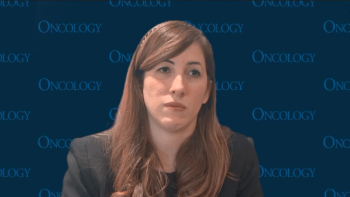
Larotrectinib Yields Enduring Responses in TRK Fusion GI Cancer
Data from the phase 2 NAVIGATE trial support the wider adoption of next-generation sequencing panels including NTRK gene fusions in the treatment of those with gastrointestinal cancers.
Patients with TRK fusion gastrointestinal cancers experienced sustained responses and tolerability following treatment with larotrectinib (Vitrakvi), according to findings from the phase 2 NAVIGATE trial (NCT02576431) presented at the
Data included the overall response rate (ORR) assessed by independent review committee (IRC) RECIST v1.1.
“Larotrectinib is the first-in-class, highly selective, central nervous system-active TRK inhibitor approved for tumor-agnostic use in adult and pediatric patients with TRK fusion cancer; approval was based on tumor response and durable efficacy,” the study authors wrote in the poster presentation.
At the cutoff date of July 20, 2023, 43 patients were IRC-eligible; the ORR was 28% (95% CI, 15%-44%). In particular, there were 3 complete responses (CR; 7%), 9 partial responses (PR; 21%), 19 patients with stable disease (SD; 44%), 5 with progressive disease (PD; 12%), and 7 not evaluable (16%). At 24 weeks, the disease control rate was 47% in all patients (95% CI, 31%-62%).
In this patient population, the median time to response was 1.8 months (range, 1.7-11.1). The median duration of response (DoR), progression-free survival (PFS), and overall survival (OS) were 27.3 months (95% CI, 5.6-not estimable [NE]), 6.1 months (95% CI, 4.8-9.2), and 12.5 months (95% CI, 6.8-29.4), respectively.
Among the 25 IRC-eligible patients with colorectal cancer, the ORR was 44% (95% CI, 24%-63%): 3 CR (12%), 8 PR (32%), 11 SD (44%), 1 PD (4%), and 2 not evaluable (8%). The 24-week disease control rate was 56% in these patients (95% CI, 35%-76%).
The median DoR, PFS, and OS for all IRC-eligible pts with CRC were 27.3 months (95% CI, 5.6-NE), 7.4 months (95% CI, 5.5-NE), and 29.4 months (95% CI, 6.8-NE), respectively. The duration of treatment ranged from 0 to 56 or more months.
“At data cutoff, 28 (64%) [total] patients had progressed on treatment, with 8 (18%) continuing treatment post-progression per investigator assessment,” the authors wrote.
Forty-four patients were included in the analysis; next-generation sequencing determined that all patients included had NTRK gene fusions. The median age was 67.0 years (range 32-90). Tumor types included colorectal (n=26), pancreatic (n=7), cholangiocarcinoma (n=4), gastric (n=3), and 1 each of appendiceal, duodenal, esophageal squamous cell carcinoma, and hepatocarcinoma. Among the patients with colorectal cancer, 15 were microsatellite instability-high (MSI-H), 9 were undetectable MSI-H (including microsatellite stable), and 2 had unknown microsatellite status.
Thirty-eight patients (86%) had received prior systemic therapy, 37 (84%) had prior surgery, and 4 (9%) had prior radiotherapy. The average number of prior systemic regimens was 2 (range 0-4); 6 patients (14%) had 0 prior lines of systemic therapy, 13 (30%) had 1 prior line, 16 (36%) had 2 prior lines, and 9 (20%) had 3 or more prior lines. Of the best responses to prior systemic therapy, 1 patient (2%) had a CR, 2 (5%) had a PR, 11 (25%) had SD, and 10 (23%) had PD.
At the data cutoff, adverse events (AEs) occurred in ≥15% of all patients with TRK fusion GI cancers. Treatment-related adverse events (TRAEs) were “predominately grade 1 or 2,” the authors wrote.
Grade 3 or 4 TRAEs were reported in 7 (16%) patients, in which the 2 most common AEs were increased alanine aminotransferase and aspartate aminotransferase. Other AEs included nausea, vomiting, anemia, diarrhea, decreased neutrophils, decreased white blood cells, fatigue, weight decrease, dizziness, and constipation. None of the patients discontinued treatment due to TRAEs.
“These data support the wider adoption of next-generation sequencing panels that include NTRK gene fusions to identify patients with GI cancer who may benefit from treatment,” the study authors wrote.
Reference
Shen L, Andre T, Chung HC, et al. Updated efficacy and safety of larotrectinib (laro) in patients (pts) with TRK fusion gastrointestinal (GI) cancer. J Clin Oncol. 2024; 42(3):109. doi: 10.1200/JCO.2024.42.3_suppl.109
Newsletter
Stay up to date on recent advances in the multidisciplinary approach to cancer.














































































